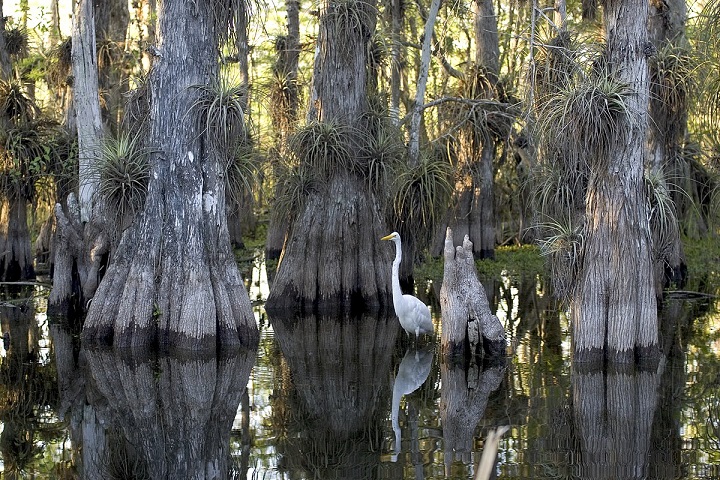Summary | Excerpt | Reviews | Beyond the Book | Read-Alikes | Genres & Themes | Author Bio

Deception, Danger, and Alligators in the Everglades
by Rebecca RennerThis article relates to Gator Country
 For thousands of years, the southern half of Florida was one of the most vibrant, unique ecosystems on Earth, composed of water flowing over land, interspersed with plant and animal life in a massive mosaic of wetlands. What came to be known as the Everglades was formed by fresh water spilling out from Lake Okeechobee and flowing slowly over the peninsula until draining into Florida Bay.
For thousands of years, the southern half of Florida was one of the most vibrant, unique ecosystems on Earth, composed of water flowing over land, interspersed with plant and animal life in a massive mosaic of wetlands. What came to be known as the Everglades was formed by fresh water spilling out from Lake Okeechobee and flowing slowly over the peninsula until draining into Florida Bay.
Starting in the mid-19th century, however, developers and residents sought to drain the wetlands and introduce agricultural and urban growth. The resulting changes nearly destroyed alligator populations and uprooted traditional livelihoods, with consequences still felt today, as Rebecca Renner explores in Gator Country: Deception, Danger, and Alligators in the Everglades.
At the turn of the 20th century, canals were built to lower the water levels on land, and farmers quickly moved in. Yet crops struggled in the soil and storms continued to cause catastrophic flooding. After a devastating hurricane in 1928, the federal government began construction of the Hoover Dike on the southern edge of Lake Okeechobee — this effectively severed the Everglades from its natural water source.
Drought in the 1930s resulted in the soil turning to dust and an explosion of destructive fires. Because the soil is peat, it would keep burning for long periods of time, and when it dried it subsided and land disappeared.
Residents and conservationists sounded the alarm about damage to the Everglades, and the idea for a national park was raised as early as 1928. In 1934, Congress authorized Everglades National Park, but it wasn't until 1947 that the park was finalized and dedicated. In 1947, the journalist and writer Marjory Stoneman-Douglas, who had argued in favor of the national park for many years, published her influential Everglades: River of Grass, which helped change perceptions of the Everglades as simply a dismal swamp and provided momentum to make the park a reality.
However, the damage done to the ecosystem by the canals and dikes resulted in more flooding throughout the region, and in the 1950s and 1960s the U.S. Army Corps of Engineers was brought in to construct a complex system of levees and more canals. These were designed to prevent flooding along the increasingly developed coast and to direct water to agricultural zones. Developments boomed following these engineering projects, but the ecological damage, including the crash in alligator populations chronicled in Renner's book, only accelerated.
Land subsidence due to hydrologic changes now threatens the continuation of agriculture in South Florida, and saltwater intrusion — when saltwater infiltrates freshwater sources and groundwater — is aggravated by the combination of land subsidence and sea-level rise. Federal and state governments belatedly realized the damage caused by this engineering, and in 2000 they announced the Comprehensive Everglades Restoration Plan (CERP), a multi-billion-dollar, multi-decade effort to restore some of the natural hydrology of the Everglades.
CERP continues to move slowly, with groundbreaking on a key reservoir at Lake Okeechobee taking place in 2023, 20 years after the passage of the plan. It is hoped that eventual reconnection of the lake and the wetlands helps the imperiled ecosystem, but as Stoneman-Douglas recognized many decades ago, the Everglades are struggling under the weight of so many environmental catastrophes.
A great egret in the Everglades, courtesy of the National Park Service
Filed under Nature and the Environment
![]() This "beyond the book article" relates to Gator Country. It originally ran in January 2024 and has been updated for the
November 2024 paperback edition.
Go to magazine.
This "beyond the book article" relates to Gator Country. It originally ran in January 2024 and has been updated for the
November 2024 paperback edition.
Go to magazine.
Your guide toexceptional books
BookBrowse seeks out and recommends the best in contemporary fiction and nonfiction—books that not only engage and entertain but also deepen our understanding of ourselves and the world around us.